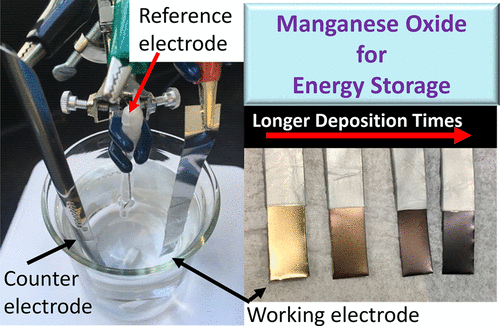当前位置:
X-MOL 学术
›
J. Chem. Educ.
›
论文详情
Our official English website, www.x-mol.net, welcomes your feedback! (Note: you will need to create a separate account there.)
Bringing Real-World Energy-Storage Research into a Second-Year Physical-Chemistry Lab Using a MnO2-Based Supercapacitor
Journal of Chemical Education ( IF 3 ) Pub Date : 2018-09-18 00:00:00 , DOI: 10.1021/acs.jchemed.8b00454 Felicia Licht 1 , Gianna Aleman Milán 1 , Heather A. Andreas 1
Journal of Chemical Education ( IF 3 ) Pub Date : 2018-09-18 00:00:00 , DOI: 10.1021/acs.jchemed.8b00454 Felicia Licht 1 , Gianna Aleman Milán 1 , Heather A. Andreas 1
Affiliation

|
As the need for alternative energy becomes increasingly important, energy research and related industries are rapidly expanding. This lab incorporates current energy-storage research into a second-year lab that instills real-world, industry-relevant knowledge and skills while teaching and reinforcing physical-chemistry concepts. A manganese oxide electrode, aqueous-Na2SO4-electrolyte supercapacitor system is used because it has no air or water sensitivity, unlike most battery technologies, so it is easy to implement in an undergraduate-lab setting. Manganese oxide is an increasingly popular supercapacitor material, and this lab introduces the concept of pseudocapacitance, in which current flows while still being governed by the Nernst equation (i.e., at equilibrium). Students conduct realistic and industrially relevant electrochemical experiments; they electrodeposit manganese oxide films and test them using cyclic voltammetry. Students compare the manganese oxide results to those from a nonpseudocapacitive system (i.e., a poor supercapacitor). In doing so, they learn the concepts of charge storage and energy and power (and their important differences), while reinforcing the physical-chemistry topics of thermodynamics and kinetics, all within a frame of familiar electrochemical knowledge (i.e., the Nernst equation). This lab can be completed in one 4 h laboratory period or in a 3 h period if the solutions are provided to the students or they prepare them a week in advance. Student interest and engagement is heightened by their being able to see the real-world applications and skills.
中文翻译:

使用基于MnO 2的超级电容器将现实世界的储能研究带入第二年的物理化学实验室
随着对替代能源的需求变得越来越重要,能源研究和相关产业正在迅速扩展。该实验室将当前的储能研究纳入了第二年的实验室,该实验室在教授和加强物理化学概念的同时灌输了与行业相关的现实世界的知识和技能。氧化锰电极,Na 2 SO 4水溶液-使用电解质超级电容器系统,因为它对空气或水不敏感,这与大多数电池技术不同,因此很容易在大学实验室环境中实施。氧化锰是一种越来越流行的超级电容器材料,该实验室引入了伪电容的概念,其中电流在流动的同时仍受能斯特方程式控制(即处于平衡状态)。学生进行现实的和与工业相关的电化学实验;他们对氧化锰膜进行电沉积,并使用循环伏安法对其进行测试。学生将锰氧化物的结果与非伪电容系统(即,超级电容器较差)的结果进行比较。通过这样做,他们学习了电荷存储以及能量和功率的概念(以及它们的重要区别),同时加强热力学和动力学的物理化学主题,所有这些都在熟悉的电化学知识(即能斯特方程)的框架内进行。如果向学生提供了解决方案或他们提前一周准备了解决方案,则该实验室可以在一个4小时的实验室时间内完成,也可以在3小时的时间内完成。他们能够看到现实世界中的应用程序和技能,从而提高了学生的兴趣和参与度。
更新日期:2018-09-18
中文翻译:

使用基于MnO 2的超级电容器将现实世界的储能研究带入第二年的物理化学实验室
随着对替代能源的需求变得越来越重要,能源研究和相关产业正在迅速扩展。该实验室将当前的储能研究纳入了第二年的实验室,该实验室在教授和加强物理化学概念的同时灌输了与行业相关的现实世界的知识和技能。氧化锰电极,Na 2 SO 4水溶液-使用电解质超级电容器系统,因为它对空气或水不敏感,这与大多数电池技术不同,因此很容易在大学实验室环境中实施。氧化锰是一种越来越流行的超级电容器材料,该实验室引入了伪电容的概念,其中电流在流动的同时仍受能斯特方程式控制(即处于平衡状态)。学生进行现实的和与工业相关的电化学实验;他们对氧化锰膜进行电沉积,并使用循环伏安法对其进行测试。学生将锰氧化物的结果与非伪电容系统(即,超级电容器较差)的结果进行比较。通过这样做,他们学习了电荷存储以及能量和功率的概念(以及它们的重要区别),同时加强热力学和动力学的物理化学主题,所有这些都在熟悉的电化学知识(即能斯特方程)的框架内进行。如果向学生提供了解决方案或他们提前一周准备了解决方案,则该实验室可以在一个4小时的实验室时间内完成,也可以在3小时的时间内完成。他们能够看到现实世界中的应用程序和技能,从而提高了学生的兴趣和参与度。



























 京公网安备 11010802027423号
京公网安备 11010802027423号